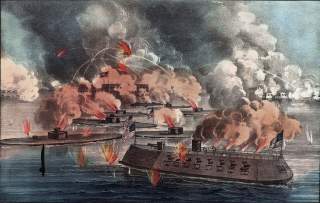A Savage War: A Military History of the Civil War
An excerpt from Williamson Murray and Wayne Wei-siang Hsieh's new book.
While the grizzled War of 1812 veteran had provided the initial impetus of making a naval blockade a crucial part of the Union’s larger military strategy to win the war, the joint Army-Navy Blockade Board that met in the late summer of 1861 provided crucial planning for such an enterprise. The brainchild of Alexander Bache, West Point graduate and head of the United States Coastal Survey, and a close associate of both senior army and navy officers, the Blockade Board deliberated on what coaling stations the navy needed to support the complicated logistics of the planned blockade. Blockading the South represented an immense task, given the 3,500 miles of coastline and ports at the disposal of Confederate blockade-runners, along with the hardly impressive naval forces at the disposal of the Union at the war’s outset— barely forty-two ships in April 1861. The major ports were New Orleans, far and away the most important, Galveston, Mobile, Savannah, Charleston, and Wilmington. There were, of course, other possibilities along the coast, but without access to the docks and railroads available in major ports, the Confederates could import only minuscule tonnage at other locations.
Union naval officers realized that they did not need to cover the entire coastline, but even the closure of the Confederacy’s major ports would require coaling stations to sustain the Union naval forces gathering together to enforce the blockade. The fact that the steam-ships of the time had to burn a ton of coal for every five to seven miles they steamed underlines the logistical importance of gaining such bases. Once in Union hands, colliers could stockpile coal for blockade vessels to replenish their supply of fuel and then return to station outside the port they were blockading, thus allowing them to remain on station for long periods of time.
Utilizing extensive information on such factors as coastal conditions, transportation links, availability of fresh water, and preexisting Confederate defenses, the board determined that the navy should establish coaling stations on the Atlantic Coast at Fernandina, Florida, and Bull’s Bay, South Carolina. Welles approved these initial recommendations, which Scott and most importantly Lincoln endorsed in late July, shortly after the defeat at Bull Run. Scott provided feedback on operational timing in a meeting on 1 August and ordered Brigadier General Thomas Sherman to organize an expeditionary force of 12,000 men to cooperate with Samuel F. DuPont, reassigned from heading the Blockade Board to command the naval component of the expedition, whose objective would eventually shift to Port Royal, South Carolina. Later in August, after an extensive survey of the complex Mississippi Delta, the board recommended the capture of Ship Island, Mississippi, located between Mobile and New Orleans, as a base for a Gulf blockading squadron. The board argued against making New Orleans an immediate Federal objective, as Scott had originally argued in his Anaconda Plan, until the navy could acquire greater resources to contend with the city’s fortifications. Whatever the merits of either case, Federal forces seized Ship Island on 17 September. The Confederates were not even in a position to defend the half-finished fort. The campaign against New Orleans would wait until the following spring.
Meanwhile, both Welles and Scott continued to act independently of the Blockade Board in accordance with their own strategic instincts. In an effort to interdict Confederate privateers harassing Union shipping from bases in the Outer Banks, Welles asked Scott to provide army troops to cooperate with a naval expedition to Hatteras Inlet. Scott ordered Major General John F. Wool at Fort Monroe on 13 August to provide the ground forces necessary for the expedition. On 29 August, the combined army-navy force under Flag Officer Silas H. Stringham and Butler seized the barrier islands that protected Pamlico and Albemarle Sounds from the raging storms that move up the coast of North Carolina. Two forts, recently built by the Confederates, had guarded the entrance to the sounds. The troops had floundered ashore on 28 August, while Butler remained on board ship and the navy reduced Fort Clark, while steaming in circles to avoid Confederate gunnery—one of the advantages steam propulsion provided that overturned the old rule that one land-based gun could match four afloat. In the age of sail, land forts had possessed a substantial advantage, because sailing ships were slow and, therefore, wonderful targets. However, steamships could escape the tyranny of winds and currents, and as swiftly moving targets they were more difficult to hit. The navy turned its attention to Fort Hatteras the following day, as wet and bedraggled troops then dragged themselves across the island to watch the surrender of the fort. The swift and easy nature of the Federal victory surprised both Union and Confederate high commands.
Williamson Murray is professor emeritus of history at Ohio State University. His many books include The Iran-Iraq War. Wayne Wei-siang Hsieh is associate professor of history at the United States Naval Academy. He is the author of West Pointers and the Civil War.
Image: “First Battle of Charleston Harbor,” hand-colored lithograph by Currier & Ives. Wikimedia Commons/Public domain

